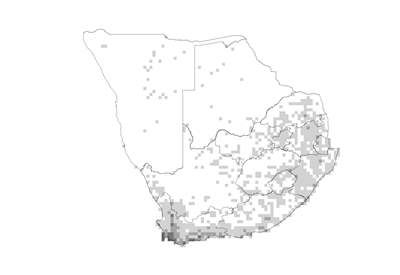 |
 Species distribution and density. Darker squares represent higher density of members of this family. |
Introduction
Fibre bark family
This medium-sized family of mostly shrubs and small trees is found in a variety of habitats around the world; mostly south of latitude 40� North.
Distribution
A cosmopolitan family found in temperate and tropical regions; well represented in Africa. In southern Africa the diversity is highest in the winter-rainfall parts of the Western Cape.
Number of genera in the world
ca. 45
Number of species in the world
ca. 890
Number of genera in the Flora of southern Africa region
8
Number of species in the Flora of southern Africa region
202
Well-known southern African genera
Dais, Gnidia, Lachnaea, Passerina
Growth forms
Mostly shrubs or small trees but also lianas and herbs.
Habitats
Found in diverse habitats including tropical rainforests, open woodland, freshwater swamps, mountains, grassland and arid plains.
Flagship species
Dais cotinifolia (pompom tree; kannabas [A]; intozane [X]; intozane-emnyama [Z]) is a medium-sized deciduous to evergreen tree found in forest margins, thickets and riverine vegetation in the eastern parts of southern Africa. It flowers from November to February and is a popular garden plant that has been cultivated in Europe since the 18th century. The bark is used to make a good rope.
Significance of the family
Some species are cultivated as ornamental shrubs (Dais, *Daphne, Gnidia). In Borneo the genus *Gonystylus is a source of timber. Essential oils are produced from the wood of certain genera (*Aquilaria, *Wikstroemia). Historically the yellow flowers of Gnidia species were used to dye leather and wool while Khoisan used the stringy bark to tie bundles of wood. Passerina bushes were used to rapidly heat up outside ovens. Some members of the family (Gnidia species) are used as a fish poison or to treat boils and coughs.
Diagnostic characters
Tough, fibrous bark . Leaves opposite or alternate, without stipules, sometimes ericoid or needle-like . Flowers long, tubular and mostly regular , often in dense heads with bracts forming an involucrum �. Sepals (4 or 5) petaloid, appearing like a continuation of the tube (hypanthium) �; petals inconspicuous � or absent. Ovary superior. Fruit an achene, berry or drupe.
Did you know?
Tubular flowers of most Gnidia and Struthiola species are sweetly scented at night and attract moths for pollination. However, the genus Passerina is wind pollinated.